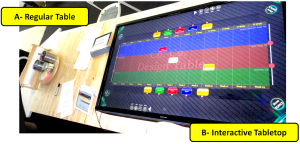This project proposes a novel principled approach and the toolset to support collocated team-based educational design by providing teachers and learning designers with an ecology of digital and non-digital devices, an embedded design pattern library and a design dashboard.
The CoCoDeS design system (COllocated COllaborative Design Surface) was created to function alongside other support tools in a purpose built design studio (see Figure below). We are particularly interested in new forms of design work that are distributed across, and take advantage of, a variety of surfaces (digital, analogue and hybrid) allowing members of design teams to operate on multiple representations of their designs, comparing and discussing candidate ideas as they move back and forth through a design process.
Rather than limiting our analysis to look at the user experience or the impact of the CoCoDes in isolation, our evaluation studies track designer-user activity across multiple tools and display surfaces paying close attention to details of the design task, mobility and users actions to get insights into how design team members are dealing with the very complex problems of educational design in the ecology of resources and support tools.
The CoCoDes user interface
CoCoDes offers a multi-touch user interface customised to support small teams who are carrying out early stage (high level) conceptual design work on tertiary education courses. CoCoDes can be deployed on an interactive tabletop and on an IWB. CoCoDes provides digital elements that can be manipulated by direct touch (by dragging digital objects and touching buttons), allowing bimanual input and fluid interaction with the visual representations of the design. This makes all team members’ actions visible and accountable to other members.
The Design Studio
CoCoDes has been implemented to operate in a design studio. This features three shared digital devices. There is the interactive, multi-touch design table itself (a 40’’ PQlabs overlay[1] was used in the studies) plus an interactive whiteboard (a projection based SmartBoard[2] was used in the studies). This configuration allows user-designers to: i) use the tabletop as the main working device, keeping the semester view on the IWB, ii) split the task so different group members can build two candidate designs in parallel or iii) compare two different designs, each showing on a different device. The third shared device is a dashboard that shows real-time quantitative indicators relating to the candidate designs created in the CoCoDes system. These indicators include i) a list of patterns added to each candidate design, ii) a pie chart that shows the total student time dedicated to each learning space, and iii) a histogram showing the student load for each week of the semester. When necessary, multiple physical keyboards can be attached to both the shared displays, to allow faster input by multiple users (e.g. so designers can define their own task names or edit pre-existing patterns).
Research
We have conducted quite transdisciplinary research based on a number of evolving user trials. For example, we have tackled these studies to develop a holistic HCI perspective (see CHI’16 paper below). Alternatively, we have also analysed designers’ activity under a CSCL lenses. We are currently working on developing methodologies to analyse collocated educational design activity by extending the Instrumental Genesis theory. You can read more about this project in the following papers:
Martinez-Maldonado, R., Goodyear, P., J.Kay, Thompson, K., and Carvalho (2016) An Actionable Approach to Understand Group Experience in Complex, Multi-surface Spaces. SIGCHI Conference: Human Factors in Computing Systems, CHI 2016, 2062-2074.
Martinez-Maldonado, R. and Goodyear, P. (2016) CoCoDeS: Cross-device Support for Collocated Collaborative Learning Design.Australian Computer-Human Interaction Conference, OZCHI 2013, pages to appear. (Acceptance Rate 45%).
Martinez-Maldonado, R., Goodyear, P., Dimitriadis, Y., Thompson, K., Carvalho, L., Prieto, L.P. and Parisio, M. (2015) Learning about Collaborative Design for Learning in a Multi-Surface Design Studio. International Conference on Computer Supported Collaborative Learning, CSCL 2015, 174-181.
Thompson, K., Martinez-Maldonado, R., Wardak, D., Goodyear, P., and Carvalho, L. Analysing F2F Collaborative Design and Learning:Experiences in a Design Studio. In Workshop on The Orchestrated Collaborative Classroom: Designing and Making Sense of Heterogeneous Ecologies of Teaching and Learning Resources – held at International Conference on Computer-Supported Collaborative Learning (CSCL 2015), Gothenburg, Sweden. 2015.
2 more papers under review and 2 being written.
[1] PQ labs http://multitouch.com/
[2] Smart technologies http://education.smarttech.com/


